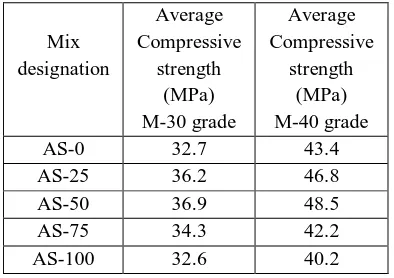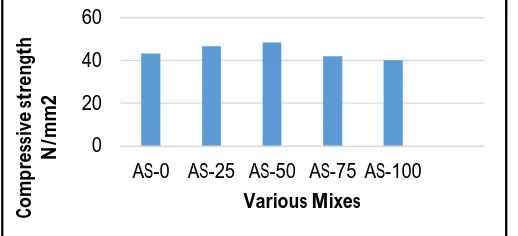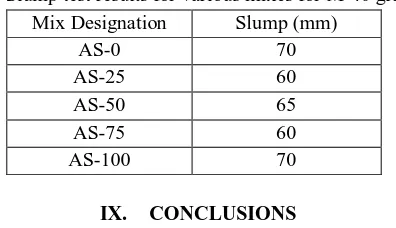Technology (IJRASET)
Effect of Replacement of River Sand with Artificial
Sand on Properties on Cement Mortar
Mr. Rushank Ravindra Patil1, Mr. D. N Shinde2
P.V.P.I.T Civil Engineering Department, Budhgaon , Sangli
Abstract— In general, the demand of natural sand is quite high in developing countries to satisfy the rapid infrastructure growth. In this situation the developing country like India is facing shortage in good quality of natural sand. Now-a-days good sand is not readily available; it is transported from a long distance. The artificial sand produced by proper machines can be a better substitute to river sand. River sand in many parts of the country is not graded properly and has excessive silt and organic impurities and these can be detrimental to durability of steel in concrete whereas Artificial sand has no silt or organic impurities Keywords—Natural sand ,silt, durability.
I. INTRODUCTION(HEADING1)
In general, the demand of natural sand is quite high in developing countries to satisfy the rapid infrastructure growth. In this situation the developing country like India is facing shortage in good quality of natural sand. Particularly in India, natural sand deposits are being depleted and causing serious threat to environment as well as the society. Properties of aggregate affect the durability and performance of concrete, so fine aggregate is an essential component of concrete and cement mortar. Now-a-days good sand is not readily available, it is transported from a long distance. The artificial sand produced by proper machines can be a better substitute to river sand. The sand must be of proper gradation (it should have particles from 150 microns to 4.75mm).When fine particles are in proper proportion, the sand will have fewer voids. The cement quantity required will be less. Such sand will be more economical. Demand for manufactured fine aggregates for making concrete is increasing day by day as river sand cannot meet the rising demand of construction sector. Because of its limited supply, the cost of natural river sand has sky rocketed and its consistent supply cannot be guaranteed. River sand in many parts of the country is not graded properly and has excessive silt and organic impurities and these can be detrimental to durability of steel in concrete whereas Artificial sand has no silt or organic impurities
II. SANDMININGANDARTIFICIALSAND A. Sand Mining
Sand mining is a practice that is used to extract sand, mainly through an open pit. However, sand is also mined from beaches, inland dunes and dredged from ocean beds and river beds. It is often usedin manufacturing as an abrasive, for example, and it is used to make concrete. As communities grow, construction requires less wood and more concrete, leading to a demand for low-cost sand.
Sand mining is a practice that is becoming an environmental issue in India. Environmentalists have raised public awareness of illegal sand mining in India. The greed of man and the demand for sand is responsible for the illegal sand mining. It has become a major issue throughout the country.
B. Artificial sand
Artificial sand is popularly known by several names such as Crushed sand, Rock sand, Green sand, Robo sand, Pozzolan sand etc. IS 383-1970 (Reaffirmed 2007) recognizes manufacture sand as 'Crushed Stone Sand' under Clause 2. Crushed stone sand is produced by crushing boulders.Artificial sand is produced by rock-on-rock or rock-on-metal Vertical Shaft Impactor (VSI) in which the process that produced alluvial deposits is closely simulated. Particle size reduction and achieving equidimesional shape is critical to get desired properties. If rock is crushed in compression lot of inherent properties exhibited by natural river sand are lost. If proper technique of manufacturing is not adopted aggregates are bound to become flaky and elongated. Improvements to sand by way of washing, grading and blending may have to be done before use at the consumer end. In case of Artificial sand all the processes mentioned above can be done at manufacturing plant itself and controls are much better in producing quality fine aggregates.
III. ISSUESWITHARTIFICIALSAND
Technology (IJRASET)
Presence of other impurities such as coal, bones, shells, mica and silt etc. makes it inferior for the use in cement concrete. The decay of these materials, due to weathering effect, shortens the life of the concrete.
Now-a-days, the Government have put ban on lifting sand from River bed. General requirements of Artificial sand
All the sand particles should have higher crushing strength. The surface texture of the particles should be smooth. The edges of the particles should be grounded.
The ratio of fines below 600 microns in sand should not be less than 30%. There should not be any organic impurities.
Silt in sand should not be more than 2%, for crushed sand.
In Artificial sand the permissible limit of fines below 75 microns shall not exceed 15%
A. Mateial and methodology
Ordinary Portland cement (OPC 43 grade) confirming to IS: 8112-1989 was used. The properties are determined as per relevant IS standards and the test results obtained are satisfying the code requirements.
Aggregates are the important constituents of concrete. They provide the bulk to the concrete, reduce shrinkage and effect economy. Aggregates occupy nearly 70-80 percent of the volume of concrete, their impact on various characteristics and properties is undoubtedly considerable.
B. Properties of cement and aggregates
1) Fine aggregates: River sand obtained from local river is used. Artificial sand obtained from Manerajuri (Gurudatta Crushers Pvt Ltd) is used. The properties are determined as per relevant IS standards and the test results obtained are:-
Table no: 1 Properties of fine aggregates.
2) Coarse Aggregates: The shape and particle size distribution of the aggregate is very important as it affects the packing and voids content. The coarse aggregate satisfying IS 383-1970 is used. The properties of coarse aggregates are to be determined as per IS: 2386-1963.The tests are conducted to find the properties of coarse aggregate and the results are tabulated as below in Table:-
Table no 2: Properties of coarse aggregates
Sr. No. Property Results
1 Specific gravity 2.77
2 Bulk density 1527 Kg/m3
3 Moisture content Nil
C. Methodology: Various steps involved in carrying out this work are as given below,
1) Total eight concrete mixes of both M30 and M40 grade are used in this experimental study.
2) A total of 26 Nos. of Cubes, 26 Nos. of Beam and 26 Nos. of Cylinders are cast. The slump was taken in the range of 55 mm to 75 mm for all the concrete mixes.
3) All the 26 cubes were cast in 150mmx150mmx150mm size mould and are well vibrated under vibrating machine in to 3 layers and the cubes were de-moulded after 24 hours and are transferred to curing tank.
4) All the cubes were tested for 28 days of curing under Compression Testing Machine so as to determine the Average Compressive Strength.
5) All the Beams were tested for 28 days of curing under Universal Testing Machine so as to determine the Average Flexural Fine Aggregates Specific Gravity Bulk Density(kg/m3)
River Sand 2.65 1567
Technology (IJRASET)
6) All the Cylinders were tested for 28 days of curing under Compression Testing Machine so as to determine the Average Split Tensile Strength.
D. Experimental procedure
1) Mix Design Proportions as PER IS 10262:2009
The mix proportions of M-30, M-40 grade concrete were obtained by IS code method (IS 10262:2009 and IS 456:2000). Following the stipulation of Mix designing concrete.
MIX DESIGN PROPORTIONS OF M-30 CONCRETE. Stipulations for Mix Proportioning a) Grade designation : M30
b) Type of cement :Coromandal King OPC 53 grade. c) Type of mineral admixture : Silica Fume
d) Maximum nominal size of aggregate : 20 mm e) Minimum cement content : 300 kg/m3 f) Maximum Water-cement ratio : 0.45 g) Workability : 50-100 mm
h) Exposure condition : Moderate
i) Degree of supervision : Good
j) Chemical admixture type : Superplasticizer
IV. TEST DATA FOR MATERIALS
A. Cement used : Coromandal King OPC 53 grade. B. Specific gravity of cement : 3.15 C. Specific gravity of superplasticizer : 1.10 D. Specific gravity of:
1) Coarse aggregate : 2.93
2) Fine aggregate : 2.74
E. Water absorption:
1) Coarse aggregate : 1.47%
Technology (IJRASET)
V. TARGET STRENGTH FOR MIX PROPORTIONING
f’ck = fck + ( 1.65 x S ) where, f’ck = Target mean compressive strength at 28 days.
fck = Characteristics compressive strength at 28 days. S =Standard deviation.
From table 1, IS 10262:2009, page no.2, Standard deviation, S = 5 N/mm2.
Therefore, Target strength = 30 + 1.65 X 5 = 38.25 N/mm2.
VI. SELECTION OF WATER-BINDER RATIO
Based on experience adopted w/c ratio to 0.40. From table 2, IS 10262:2009, page no.3,
Maximum water content for 20 mm aggregate = 186 littre
Estimated water content for 100 mm slump = 186 + x 186 = 197 litre
As superplasticizer is used water content reduced to 29%. Hence arrived water content is given by, = 197.16 X 0.71
= 140 litres. ….(4.3.2)
Binder content can be find out from the w/c ratio as, = water to binder ratio
Therefore, binder content = =
. = 350 kg/m3 ….(4.3.3)
VII. COMPRESSIONSTRENGTHTEST
Standard cube specimens were cast using the procedure described in IS: 516–1959 and were kept there for 24 hours and then released in water tank for 28 days of curing. After 28 days curing period, the concrete cube specimen cast by replacing natural sand with artificial sand at different replacement levels were tested under a compression testing machine at a rate of 140 kg/cm2/min. A set of three cubes were tested for all six mixes. The compression strength is found out by dividing maximum load resisted by cross sectional area of cube specimen.
[image:5.612.208.405.536.675.2]3 cubes each from 6 mixes were tested for compressive strength at room temperature. The following Table.4.2presents the compressive strength results at 28 days of curing at room temperature.
Table no 3. 28 days Compressive strength of M-30 & M-40 grade Concrete.
Mix designation
Average Compressive
strength (MPa) M-30 grade
Average Compressive
strength (MPa) M-40 grade
AS-0 32.7 43.4
AS-25 36.2 46.8
AS-50 36.9 48.5
AS-75 34.3 42.2
Technology (IJRASET)
Fig no 1:-Variation in compressive strength (28 days) for various mixes for M-30 grade concrete.
Fig no 2:-Variation in compressive strength (28 days) for various mixes for M-40 grade concrete
VIII. OBSERVATIONS
As the percentage replacement of natural sand by Artificial sand increases the resulting compressive strength is also increases.
For 20% of replacement the compressive strength is nearly the same but for beyond 40 % of replacement the compressive strength increases considerably.
For the 100 % replacement natural sand by Artificial sand the increase in compressive strength is nearly 16.78% at 28 days. This increase in strength is mainly due to the good bond characteristics of Artificial sand. A good bond is essential for improving strength of concrete composite. The interfacial bond increased by larger area of contact, improving the frictional properties. The artificial sand contains more micro fines as compared to river sand which provides larger area of contact also particle shape of artificial sand is cubical, angular which is the main reason to get increased strength.
A. Results nad discussions
The use of Artificial sand at any level of replacement as a fine aggregate in concrete/mortar reduces the workability of concrete/mortar. It is due to the fact that as the finer material increases, more is the surface area and hence more water is required for wetting the surface. For the given fixed quantity of water as the finer material increases the workability decreases. The workability can be increased by adding suitable dosage of chemical admixture.
Slump cone test was carried out to check the workability of concrete various replacement level of natural sand by Artificial sand. Several trials were conducted to fix the dosage of super plasticizer to get the acceptable range of workability.
Table 4:Slump test results for various mixes for M-30 grade
Mix Designation Slump (mm)
AS-0 70
AS-25 65
AS-50 70
AS-75 60
AS-100 70
30 32 34 36 38
0 25 5075 AS-100 C o m p re ss iv e st re n gt h N /m m 2 Various Mixes 0 20 40 60
AS-0 AS-25 AS-50 AS-75 AS-100
[image:6.612.179.438.250.368.2]Technology (IJRASET)
Table 5: Slump test results for various mixes for M-40 grade.Mix Designation Slump (mm)
AS-0 70
AS-25 60
AS-50 65
AS-75 60
AS-100 70
IX. CONCLUSIONS Conclusions of work are given below.
A. The results of the present research work concludes that the compressive strength, tensile strength and flexure strength of concrete is significantly improved by partial replacement of Artificial sand for fine aggregate.
B. It is observed from the experimental results that, the Artificial sand replaced concrete have 13% more compressive strength for M30 grade,11% more compressive strength for M40 grade up to 50% replacement of Artificial sand and further increase in the percentage of Artificial sand showed reduced the strength.
C. The experimental results proved that the split tensile strength of concrete increased by 20% and 14% for M30, M40 grade concrete, when compared with conventional concrete up to 50% replacement of Artificial sand with river sand.
D. The Flexure strength of concrete increased by 25% for M30 grade, 17% for M40 grade and 50% replacement of Artificial sand with river sand. When the percentage of replacement of Artificial sand goes beyond 50%, the strength is considerably reduced. E. It is observed that market rate of river sand is Rs 6000/- per brass whereas the market rate of Artificial sand is Rs 3000/- per
brass, as the Artificial sand is 50% cheaper than Natural sand this may reduce the cost of production of concrete.
REFERENCES
[1] H. Donza, O. Cabrera, E.F. Irassar., (2002), High-strength concrete with different fine aggregate, Cement and Concrete Research, Vol.32 pp.1755-1761.
[2] M.C.Nataraja, A.S. Manu and G.Girish (January 2014),Utilization of different types of manufactured sand as fine aggregate in cement mortar, Indian Concrete Journal, Vol.88,pp.19-25.
[3] Li Beixing, Wang Jiliang, Zhou Mingkai, (2009),Effect of limestone fines content in manufactured sand on durability of low- and high-strength concretes, Construction and Building Materials, Vol.23 pp.2846-2850.
[4] Prakash Nanthagopalan, Manu Santhanam.,(2011),Fresh and hardened properties of self-compacting concrete produced with manufactured sand, Cement & Concrete Composites,Vol.33, pp.353-358.
[5] J.P. Gonçalves, L.M. Tavares, R.D. Toledo Filho, E.M.R. Fairbairn, E.R. Cunha (2007), Comparison of natural and manufactured fine aggregates in cement mortars, Cement and Concrete Research, Vol.37, pp.924-932.
[6] K. Balaji Rao, V. Bhaskar Desai, D. Jagan Mohan (2012), Probabilistic analysis of Mode II fracture of concrete with crushed granite stone fine aggregate replacing sand, Construction and Building Materials, Vol.27, pp.319-330.
[7] M. G. Shaikh,S. A. Daimi,(2011), Durability studies of concrete made by using artificial sand with dust and natural sand,International Journal of Earth Sciences and Engineering,Vol.04, pp 823-825.
[8] M. R. Chitlange,. P. S. Pajgade,P. B. Nagarnaik, (2008),Experimental Study of Artificial Sand Concrete,IEEE(Proceedings of the 2008First International Conference on Emerging Trends in Engineering and Technology),pp.1050-1054.
[9] Tahir Celik and Khaled Marar, (1996), Effects of crushed stone dust on some properties of concrete, Cement and Concrete Research,Vol.7, pp. 1121-1130.
[10] S.Elavenil,B. Vijaya (2013),Manufactured Sand, A Solution And An Alternative To River Sand And In Concrete Manufacturing, Journal of Engineering, Computers & Applied Sciences (JEC&AS),Volume 2, No.2, ,February 2013 .
[11] Priyanka A. Jadhav, Dilip K. Kulkarni (2013), Effect of replacement of natural sand by manufactured sand on the properties of cement mortar, International Journal Of Civil And Structural Engineering, Vol.3, No 3, 2013.
[12] Wakchaure M. R, Er. Shaikh A.P, Er. Gite B.E.(2012) Effect of Types of Fine Aggregate on Mechanical Properties of Cement Concrete, International Journal of Modern Engineering Research (IJMER), Vol.2, pp.3723-3726.


